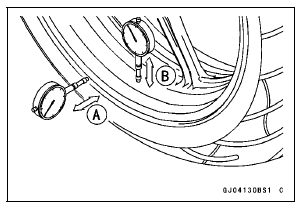

Special Tools - Jack: 57001-1238 Jack Attachment: 57001-1608

If roughness or binding is found, replace the hub bearings (see Hub Bearing Removal/Installation).
If there is any damage to the wheel, replace the wheel.
If rim runout exceeds the service limit, check the hub bearings (see Hub Bearing Inspection).
If the problem is not due to the bearings, replace the wheel.
Rim Runout (with tire installed) Standard: Axial TIR 0.5 mm (0.02 in.) or less
Radial TIR 0.8 mm (0.03 in.) or less
Service Limit: Axial TIR 1.0 mm (0.04 in.)
Radial TIR 1.0 mm (0.04 in.)
| WARNING Damaged wheel parts may fail and cause an accident resulting in serious injury or death. Never attempt to repair a damaged wheel part. If the wheel part is damaged, it must be replaced with a new one. |
 Rear Wheel Installation
Rear Wheel Installation Axle Inspection
Axle InspectionFuse Box Fuse Removal
Remove the left upper inner fairing (see Upper Inner Fairing
Removal in the Frame chapter).
Unlock the hook [A] to take off the fuse box 1 [B].
Unlock the hook [C] to lift up the lid.
Pull the fuses [A] straight out of the fuse box 1 with needle
nose pliers.
Fuse Box 2
...
Cylinder Head Cover Installation
Replace the cylinder head cover gasket [A] with a new
one
Using a high flash-point solvent, clean off any oil or dirt
that may be on the silicone sealant coating area. Dry
them with a clean cloth.
Apply silicone sealant [B] to the cylinder head as shown
in the figure.
Sealant - Li ...
Terminal Numbers of ECU Connectors
1. Subthrottle Valve Actuator: Y/BK
2. Subthrottle Valve Actuator: BK/O
3. Unused
4. Front Wheel Rotation Sensor Signal: G/Y
5. Unused
6. Starter Lockout Switch: R/G
7. Gear Position Switch: G/R
8. Crankshaft Sensor (–): BK
9. Power Supply to Sensors: BL
10. Unused
11. Intake Air Pre ...